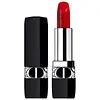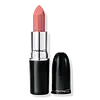What's inside
What's inside
 Key Ingredients
Key Ingredients

 Benefits
Benefits

 Concerns
Concerns

 Ingredients Side-by-side
Ingredients Side-by-side

Polyglyceryl-2 Triisostearate
EmulsifyingHydrogenated Polyisobutene
EmollientOctyldodecanol
EmollientSynthetic Wax
AbrasiveC10-30 Cholesterol/Lanosterol Esters
EmulsifyingTrimethylolpropane Triisostearate
EmollientHydrogenated Microcrystalline Wax
Emulsion StabilisingPolybutene
Cera Alba
EmollientCI 77220
Cosmetic ColorantEthylhexyl Palmitate
EmollientPolyethylene
AbrasiveButyrospermum Parkii Butter
Skin ConditioningCalcium Aluminum Borosilicate
Disteardimonium Hectorite
StabilisingPrunus Amygdalus Dulcis Oil
Skin ConditioningButyrospermum Parkii Butter Unsaponifiables
Skin ConditioningParfum
MaskingPaeonia Officinalis Flower Extract
TonicSimmondsia Chinensis Seed Oil
EmollientPropylene Carbonate
SolventPunica Granatum Flower Extract
Skin ConditioningPolyglyceryl-3 Diisostearate
EmulsifyingTrihydroxystearin
Skin ConditioningPropyl Gallate
AntioxidantTocopherol
AntioxidantSodium Hyaluronate
HumectantGlucomannan
Skin ConditioningCI 12085
Cosmetic ColorantCI 15850
Cosmetic ColorantCI 15985
Cosmetic ColorantCI 17200
Cosmetic ColorantCI 19140
Cosmetic ColorantCI 42090
Cosmetic ColorantCI 45380
Cosmetic ColorantCI 45410
Cosmetic ColorantCI 73360
Cosmetic ColorantCI 77163
Cosmetic ColorantCI 77491
Cosmetic ColorantCI 77492
Cosmetic ColorantCI 77499
Cosmetic ColorantCI 77742
Cosmetic ColorantCI 77891
Cosmetic ColorantPolyglyceryl-2 Triisostearate, Hydrogenated Polyisobutene, Octyldodecanol, Synthetic Wax, C10-30 Cholesterol/Lanosterol Esters, Trimethylolpropane Triisostearate, Hydrogenated Microcrystalline Wax, Polybutene, Cera Alba, CI 77220, Ethylhexyl Palmitate, Polyethylene, Butyrospermum Parkii Butter, Calcium Aluminum Borosilicate, Disteardimonium Hectorite, Prunus Amygdalus Dulcis Oil, Butyrospermum Parkii Butter Unsaponifiables, Parfum, Paeonia Officinalis Flower Extract, Simmondsia Chinensis Seed Oil, Propylene Carbonate, Punica Granatum Flower Extract, Polyglyceryl-3 Diisostearate, Trihydroxystearin, Propyl Gallate, Tocopherol, Sodium Hyaluronate, Glucomannan, CI 12085, CI 15850, CI 15985, CI 17200, CI 19140, CI 42090, CI 45380, CI 45410, CI 73360, CI 77163, CI 77491, CI 77492, CI 77499, CI 77742, CI 77891
Diisostearyl Malate
EmollientCaprylic/Capric Triglyceride
MaskingRicinus Communis Seed Oil
MaskingHydrogenated Polydecene
EmollientBis-Diglyceryl Polyacyladipate-2
EmollientPolyethylene
AbrasiveTrioctyldodecyl Citrate
EmollientPolybutene
Silica
AbrasiveOzokerite
Emulsion StabilisingEuphorbia Cerifera Wax
Octyldodecanol
EmollientCalcium Aluminum Borosilicate
Tocopheryl Acetate
AntioxidantSodium Hyaluronate
HumectantSqualane
EmollientButyrospermum Parkii Butter
Skin ConditioningCocos Nucifera Oil
MaskingGlycine Soja Seed Extract
Skin ConditioningHordeum Vulgare Extract
EmollientOlea Europaea Fruit Oil
MaskingRubus Idaeus Seed Oil
EmollientSimmondsia Chinensis Seed Oil
EmollientTriticum Vulgare Germ Extract
Skin ConditioningC12-15 Alkyl Benzoate
AntimicrobialCeramide Ng
Skin ConditioningTribehenin
EmollientPalmitoyl Hexapeptide-12
Skin ConditioningTitanium/Titanium Dioxide
Cosmetic ColorantAlumina
AbrasiveSynthetic Fluorphlogopite
Aluminum Calcium Sodium Silicate
Calcium Sodium Borosilicate
Tin Oxide
AbrasivePEG-10 Phytosterol
EmulsifyingLinoleic Acid
CleansingEthylhexyl Hydroxystearate
EmollientPhytosteryl Isostearate
Skin ConditioningHydrogenated Castor Oil
EmollientVanillin
MaskingTetrahexyldecyl Ascorbate
AntioxidantPhenoxyethanol
PreservativeMica
Cosmetic ColorantCI 77891
Cosmetic ColorantCI 77491
Cosmetic ColorantCI 77492
Cosmetic ColorantCI 77499
Cosmetic ColorantCI 77163
Cosmetic ColorantCI 77400
Cosmetic ColorantCI 42090
Cosmetic ColorantCI 75470
Cosmetic ColorantCI 15850
Cosmetic ColorantCI 45380
Cosmetic ColorantCI 45410
Cosmetic ColorantCI 73360
Cosmetic ColorantCI 17200
Cosmetic ColorantCI 19140
Cosmetic ColorantCI 15985
Cosmetic ColorantDiisostearyl Malate, Caprylic/Capric Triglyceride, Ricinus Communis Seed Oil, Hydrogenated Polydecene, Bis-Diglyceryl Polyacyladipate-2, Polyethylene, Trioctyldodecyl Citrate, Polybutene, Silica, Ozokerite, Euphorbia Cerifera Wax, Octyldodecanol, Calcium Aluminum Borosilicate, Tocopheryl Acetate, Sodium Hyaluronate, Squalane, Butyrospermum Parkii Butter, Cocos Nucifera Oil, Glycine Soja Seed Extract, Hordeum Vulgare Extract, Olea Europaea Fruit Oil, Rubus Idaeus Seed Oil, Simmondsia Chinensis Seed Oil, Triticum Vulgare Germ Extract, C12-15 Alkyl Benzoate, Ceramide Ng, Tribehenin, Palmitoyl Hexapeptide-12, Titanium/Titanium Dioxide, Alumina, Synthetic Fluorphlogopite, Aluminum Calcium Sodium Silicate, Calcium Sodium Borosilicate, Tin Oxide, PEG-10 Phytosterol, Linoleic Acid, Ethylhexyl Hydroxystearate, Phytosteryl Isostearate, Hydrogenated Castor Oil, Vanillin, Tetrahexyldecyl Ascorbate, Phenoxyethanol, Mica, CI 77891, CI 77491, CI 77492, CI 77499, CI 77163, CI 77400, CI 42090, CI 75470, CI 15850, CI 45380, CI 45410, CI 73360, CI 17200, CI 19140, CI 15985
 Reviews
Reviews

Ingredients Explained
These ingredients are found in both products.
Ingredients higher up in an ingredient list are typically present in a larger amount.
This ingredient is also known as shea butter. It is an effective skin hydrator and emollient.
Emollients help soothe and soften your skin. It does this by creating a protective film on your skin. This barrier helps trap moisture and keeps your skin hydrated. Emollients may be effective at treating dry or itchy skin.
Shea butter is rich in antioxidants. Antioxidants help fight free-radicals, or molecules that may harm the body. It is also full of fatty acids including stearic acid and linoleic acid. These acids help replenish the skin and keep skin moisturized.
While Shea Butter has an SPF rating of about 3-4, it is not a sunscreen replacement.
Shea butter may not be fungal acne safe. We recommend speaking with a professional if you have any concerns.
Learn more about Butyrospermum Parkii ButterCalcium Aluminum Borosilicate is made up of calcium, aluminum, and silicates. It is a glass-like material. In cosmetics, it comes in the form of flakes or microspheres.
Calcium aluminum borosilicate is a bulking agent, meaning it helps thicken a product.
This ingredient is created by slowly mixing several minerals, including kaolin clay.
Although “aluminum” in an ingredient name can raise red flags for some consumers, the form and usage context matter significantly. For typical topical applications, there is no substantial evidence of health risks - such as cancer, neurotoxicity, or systemic “aluminum overload.”
Learn more about Calcium Aluminum BorosilicateCi 15850 is the pigment color red. It is an azo dye and created synthetically.
Azo dyes need to be thoroughly purified before use. This allows them to be more stable and longer-lasting.
This ingredient is common in foundations, lipsticks, and blushes. This color is described as brown/orangey red.
It has many secondary names such as Red 6 and Red 7. According to a manufacturer, Red 6 usually contains aluminum.
Learn more about CI 15850Ci 15985 is a dye made from petroleum. It is synthetically created and approved by the FDA for use in foods and cosmetics.
The color of this dye is orange/yellow.
This ingredient can be found in makeup, sun care, and skincare.
Learn more about CI 15985Ci 17200 is a synthetic reddish-purple dye.
CI 19140 is also known as Tartrazine. Tartrazine is a synthetic dye used in cosmetics, foods, and medicine to add a yellow color.
Tartrazine is created from petroleum and is water-soluble.
Some people may experience allergies from this dye, especially asthmatics and those with an aspirin intolerance.
Learn more about CI 19140Ci 42090 is a synthetic dye created from petroleum. It is used to give a bright blue color to cosmetics, medicine, and food.
Ci 45380 is a synthetic dye that comes from coal or tar sources. Due to this, it is often used in small quantities.
A common name for this dye is Red 22. Red 22 imparts a warm reddish color.
Similar to Red 27, this dye changes color based on pH and moisture levels.
This dye is colorless when dry but turns pink between pH levels 0.0 to ~3.0.
Learn more about CI 45380CI 45410 is a synthetic red-pigment and dye.
It often goes by both Red 28 or Red 27; manufacturers label both ingredients as CI 45410.
This dye is commonly found in makeup because it imparts a vivid color. Some types of this dye change color based on pH level and interaction with moisture:
Your skin has a natural pH of around 4.5 - 5.5.
According to the FDA, CI 45410 is not permitted for use in eye products.
Red 27 is a flourescein dye and commonly used as a fluorescent tracer in medicine.
Learn more about CI 45410Ci 73360 is a synthetic red-pink dye.
This synthetic powder is used to add a pearly/white color in cosmetics.
Ci 77491 is also hydrated iron III oxide. It's sole purpose is to give a red/pink hue to products.
Iron III oxides are classified as inorganic chemicals for coloring.
Synthetically created Ci 77491 is considered safer than those naturally found. This is because the synthetically created version may contain less impurities. Iron oxides are generally non-toxic and non-allergenic.
Learn more about CI 77491Ci 77492 is also hydrated iron III oxide. It's sole purpose is to give a yellow hue to products.
Iron III oxides are classified as inorganic chemicals for coloring.
Synthetically created Ci 77492 is considered safer than those naturally found. This is because the synthetically created version may contain less impurities. Iron oxides are generally non-toxic and non-allergenic.
Learn more about CI 77492Ci 77499 is also hydrated iron III oxide. It is created from mixing red and black iron oxides. This helps give shades of darkness to a product.
Iron III oxides are classified as inorganic chemicals for coloring.
Ci 77891 is a white pigment from Titanium dioxide. It is naturally found in minerals such as rutile and ilmenite.
It's main function is to add a white color to cosmetics. It can also be mixed with other colors to create different shades.
Ci 77891 is commonly found in sunscreens due to its ability to block UV rays.
Learn more about CI 77891Octyldodecanol is a fatty alcohol. It is primarily used to enhance the texture of products.
As an emulsifier, Octyldodecanol helps prevent the oils and waters from separating. It also prevents ingredients from creating foam when shaken.
Octyldodecanol is created by reducing fatty acid to an alcohol.
Due to its high molecular weight, it does not get absorbed into the skin.
Learn more about OctyldodecanolPolybutene is used to help control the viscosity of a product. This just means it helps adjusts the texture.
It is a polymer and does not get absorbed into the skin due to its large size.
Studies found this ingredient did not irritate skin in concentrations below 15%.
Learn more about PolybutenePolyethylene is a synthetic ingredient that helps the skin retain moisture. It is a polymer.
It is also typically used within product formulations to help bind solid ingredients together and thicken oil-based ingredients. When added to balms and emulsions, it helps increase the melting point temperature.
This oil comes from the seeds of the desert shrub called Jojoba. It is more commonly known as jojoba oil, a non-comedogenic oil.
Jojoba oil does not contain fragrance and has many fatty-acids, making it a great soothing ingredient.
It also contains Vitamin E, a great moisturizing ingredient. Vitamin E is also an antioxidant and protects your skin against oxidative damage.
This ingredient humectant properties, meaning it helps draw moisture from the air. This helps keep your skin hydrated.
While jojoba has antibacterial properties, it is only able to kill some strains of bacteria.
Studies also show it helps in wound healing. In fact, Indigenous cultures have used jojoba as a moisturizer and to help treat burns for centuries.
Fun fact: Jojoba oil similar to natural human skin sebum, so it has a great effect on dry skin. It is also promising with helping to regulate sebum production.
Due to its fatty acid content, Jojoba oil may not be fungal acne safe. We recommend speaking with a professional if you have any concerns.
Learn more about Simmondsia Chinensis Seed OilSodium Hyaluronate is hyaluronic acid's salt form. It is commonly derived from the sodium salt of hyaluronic acid.
Like hyaluronic acid, it is great at holding water and acts as a humectant. This makes it a great skin hydrating ingredient.
Sodium Hyaluronate is naturally occurring in our bodies and is mostly found in eye fluid and joints.
These are some other common types of Hyaluronic Acid:
Learn more about Sodium Hyaluronate